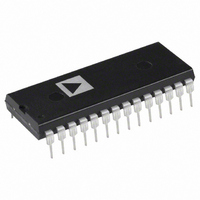AD667JN Analog Devices Inc, AD667JN Datasheet - Page 7

AD667JN
Manufacturer Part Number
AD667JN
Description
IC DAC 12BIT V-OUT 28-DIP
Manufacturer
Analog Devices Inc
Datasheet
1.AD667JNZ.pdf
(8 pages)
Specifications of AD667JN
Settling Time
3µs
Rohs Status
RoHS non-compliant
Number Of Bits
12
Number Of Converters
1
Voltage Supply Source
Dual ±
Power Dissipation (max)
1W
Operating Temperature
0°C ~ 70°C
Mounting Type
Through Hole
Package / Case
28-DIP (0.600", 15.24mm)
Resolution (bits)
12bit
Data Interface
CMOS, Byte, Nibble, Parallel, TTL
Digital Ic Case Style
DIP
No. Of Pins
28
Operating Temperature Range
0°C To +70°C
Update Rate
0.5MSPS
Package
28PDIP W
Resolution
12 Bit
Conversion Rate
500 KSPS
Architecture
Current Steering
Digital Interface Type
Parallel
Number Of Outputs Per Chip
1
Output Type
Voltage
Full Scale Error
±0.2 %FSR
Integral Nonlinearity Error
±0.75 LSB
Maximum Settling Time
4 us
Lead Free Status / RoHS Status
Contains lead / RoHS non-compliant
Available stocks
Company
Part Number
Manufacturer
Quantity
Price
Part Number:
AD667JN
Manufacturer:
ADI/亚德诺
Quantity:
20 000
Company:
Part Number:
AD667JNZ
Manufacturer:
PSPR
Quantity:
6 220
Part Number:
AD667JNZ
Manufacturer:
ADI/亚德诺
Quantity:
20 000
REV. A
It is permissible to enable more than one of the latches simulta-
neously. If a first rank latch is enabled coincident with the sec-
ond rank latch, the data will reach the second rank correctly if
the “WRITE CYCLE #1” timing specifications are met.
CS A3 A2 A1 A0 Operation
1
X
0
0
0
0
0
“X” = Don’t Care.
INPUT CODING
The AD667 uses positive-true binary input coding. Logic “1” is
represented by an input voltage greater than 2.0 V and Logic
“0” is defined as an input voltage less than 0.8 V.
Unipolar coding is straight binary, where all zeroes (000
the data inputs yields a zero analog output and all ones (FFF
yields an analog output 1 LSB below full scale.
Bipolar coding is offset binary, where an input code of 000
yields a minus full-scale output, an input of FFF
put 1 LSB below positive full scale, and zero occurs for an input
code with only the MSB on (800
The AD667 can be used with twos complement input coding if
an inverter is used on the MSB (DB11).
DIGITAL INPUT CONSIDERATIONS
The threshold of the digital input circuitry is set at 1.4 volts and
does not vary with supply voltage. The input lines can thus in-
terface with any type of 5 volt logic. The configuration of the in-
put circuit is shown in Figure 6.
X
1
1
1
1
0
0
Figure 6. Equivalent Digital Input Circuit
1
1
1
0
1
0
X
Figure 5. AD667 Block Diagram
1
1
0
1
1
0
X
Table II. AD667 Truth Table
1
0
1
1
1
0
X
No Operation
No Operation
Enable 4 LSBs of First Rank
Enable 4 Middle Bits of First Rank
Enable 4 MSBs of First Rank
Loads Second Rank from First Rank
All Latches Transparent
H
).
H
yields an out-
H
) on
H
H
)
–7–
The AD667 data and control inputs will float to a Logic 0 if left
open. It is recommended that any unused inputs be connected
to power ground to improve noise immunity.
Fanout for the AD667 is 100 when used with a standard low
power Schottky gate output device.
8-BIT MICROPROCESSOR INTERFACE
The AD667 interfaces easily to 8-bit microprocessor systems of
all types. The control logic makes possible the use of right- or
left-justified data formats.
Whenever a 12-bit DAC is loaded from an 8-bit bus, two bytes
are required. If the program considers the data to be a 12-bit
binary fraction (between 0 and 4095/4096), the data is left-
justified, with the eight most significant bits in one byte and the
remaining bits in the upper half of another byte. Right-justified
data calls for the eight least significant bits to occupy one byte,
with the 4 most significant bits residing in the lower half of an-
other byte, simplifying integer arithmetic.
Figure 8 shows an addressing scheme for use with an AD667 set
up for left-justified data in an 8-bit system. The base address is
decoded from the high-order address bits and the resultant
active-low signal is applied to CS. The two LSBs of the address
bus are connected as shown to the AD667 address inputs. The
latches now reside in two consecutive locations, with location
X01 loading the four LSBs and location X10 loading the eight
MSBs and updating the output.
Figure 7. 12-Bit Data Formats for 8-Bit Systems
Figure 8. Left-Justified 8-Bit Bus Interface
AD667










